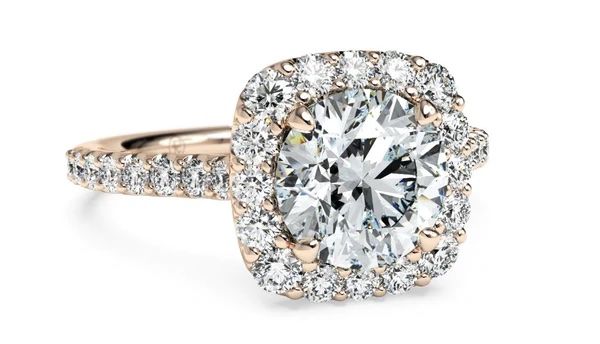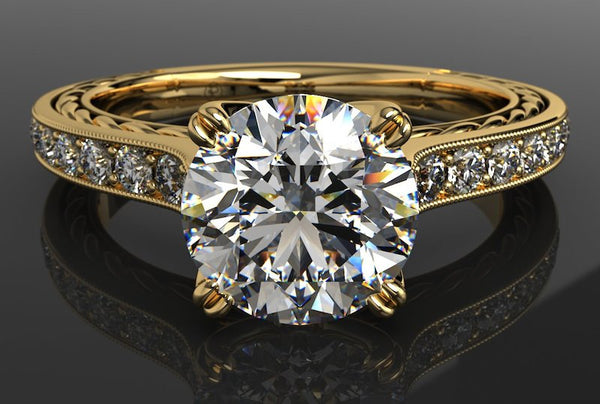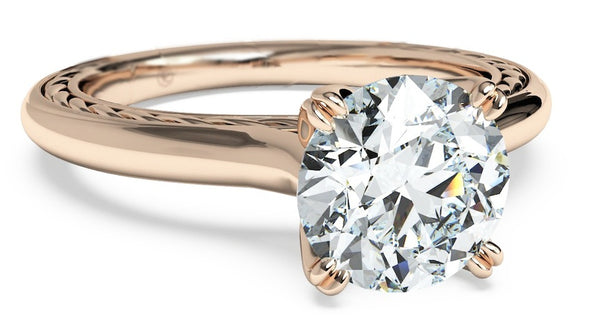Choosing a Diamond for Yellow and Rose Gold

Colored metals are making a comeback in jewelry. Rose gold has continued to grow as a trend in recent years, and yellow gold is finally starting to regain popularity. When it comes to shopping for diamonds, white metals such as white gold and platinum are excellent for supporting a stone’s natural flash.
However, if you have a preference for colored metals, how do you choose a diamond and a metal that will complement each other? Not every diamond shape will look its best when set in rose or yellow gold. Here are some tips for selecting the perfect diamond to go with colored metal.
The best diamonds for yellow and rose gold

Fancy colored, radiant, and cushion cut diamonds are the best diamond shapes for colored metal jewelry. Cushion and radiant cuts have similar shapes and faceting patterns, and they both reflect the light and color from rose and yellow gold attractively.
Certain fancy colored diamonds pair well with colored metals. My advice is to choose a diamond with a hue that contrasts with the metal’s color. For example, a yellow diamond set in yellow gold is not necessarily the best pairing. The diamond and the metal will be competing for the spotlight by having similar yellow hues. On the other hand, a blue or green diamond will look stunning set in yellow.
Rose gold’s coloring is not as intense as yellow gold. So, it is easier to choose a colored diamond that suits this metal. Pink, purple, green, and blue diamonds all look beautiful set in pink gold engagement rings.
Step cut diamonds

If you’re planning to set a diamond in colored gold, you should consider staying away from the step cut diamonds: Asschers and emeralds. Asscher and emerald cuts draw their light and sparkle from the bottom – or pavilion – of the diamond. Because of their shape, step cut diamonds are held closer to the metal in a piece of jewelry. This results in step cut diamonds reflecting more of the yellow and rosy tones in colored metal than other diamond cuts would.
You don’t want to invest in a step cut diamond with an E or F color grade and then have it set in a colored metal. The diamond will appear to have a lower color grade than it actually has due to the step cut shape.
How can you get the most for your money?
If you’re looking for where you can save money on a diamond you want to set in a colored metal, look no further than the stone’s color grade. For diamonds with color grades of I and J, the slight yellow tinge will actually be hidden rather than emphasized by the colors in yellow and rose gold. So, if you’re planning on setting the diamond you purchase in a colored metal, you don’t have to invest in a perfectly colorless stone.

Size (kind of) matters
It is important to take a diamond’s size into account before you have it set in a colored metal. It almost goes without saying that the larger a diamond is, the more you want it to be the main focal point of a jewelry piece. This goes for both colorless and fancy colored diamonds, of course. The higher the carat weight, the more likely you are to find it set in a white metal rather than colored. Without having a true color of their own, white metals make it easier to highlight the diamond.
However, if you want a colored metal and you know that’s the best way to suit your style, there’s no need to conform to the usual!
Settings matter, too

As I mentioned previously with step cut diamonds, a setting that holds the diamond closer to the jewelry’s metal can cause diamond color concerns. Tension and bezel settings may cause your diamond to reflect some of the metal’s color, thus changing the stone’s appearance. Make sure you have a good sense of what your jewelry will look like with if you select a setting that positions the diamond close to the metal. With a feature like our free in-store preview, you can make sure that your setting and metal choices are not affecting the appearance of your diamond.
Skin sensitivity
A final word of advice – make sure you don’t have any skin sensitivity or allergies before you decide to set a diamond in a colored metal. Platinum is an immensely popular white metal choice, partly because it is hypoallergenic. Some people have to stay away from colored metals because they are at risk for an allergic reaction. It is always best to verify that you aren’t allergic to yellow gold or rose gold before you decide to buy colored gold jewelry.


